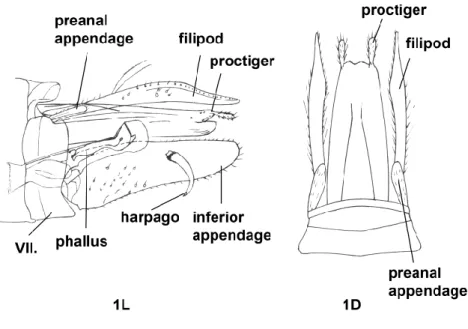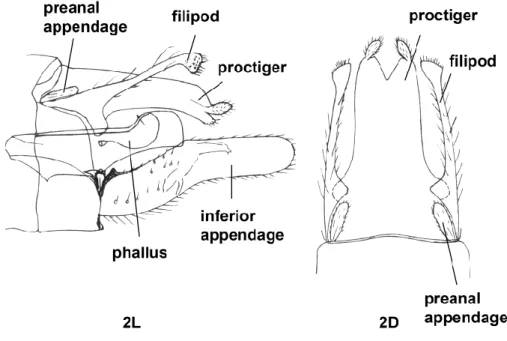Three new species of Apsilochorema Ulmer, 1907 from Nepal (Trichoptera: Hydrobiosidae)
Ottó Kiss
Citation. Kiss O. 2020: Three new species of Apsilochorema Ulmer, 1907 from Nepal (Trichoptera: Hydrobio- sidae). – e-Acta Naturalia Pannonica 20: 0–00. https://doi.org/10.24369/eANP.2020.20.55
Abstract. Three new species of Apsilochorema (Trichoptera: Hydrobiosidae), Apsilochorema biguensis n.
sp., Apsilochorema tarebhiri n. sp., and Apsilochorema yamphudini n. sp. from Nepal are described and il- lustrated with drawings of the genitalia. Thus, the number of species in the genus known from the country is increased to 9.
Keywords: Caddisflies, new species, genital structure, Nepal.
Author’s address. Ottó Kiss ǀ Bajcsy-Zs. u 4. ǀ 3014 Hort, Hungary ǀ E-mail: otto_kiss@freemail.hu Introduction
The family Hydrobiosidae was originally established by Ulmer (1905) as a subfamily of Rhyacophilidae but Schmid (1970) elevated it to the family level. Later the entire family was revised by Schmid (1989). Mey (1999) rendered an explanation for the dis- tribution of genus Apsilochorema on the Asian continent and in the SW Pacific region including Australia. A review of the species of Apsilochorema and their relationships was provided by Mey (1999), differentiating 5 groups: A. indicum, A. moselyelum, A.
excisum, A. nigrum and A. malayanum. Strandberg and Johanson (2010) conducted a phylogenetic analysis of the genus Apsilochorema. This family is represented by 52 genera, including 410 species. The genus Apsilochorema includes a total of 56 species, of which 31 and 12 species are from the Oriental Region and India, respectively (Saini et al 2013, Parey and Pandher 2016, Morse 2017). Kiss and Malicky (2003) reported 3 Apsilochorema species, Malicky (2006, 2010, 2017), and Mattern also (2015) reported 6 Apsilochorema species from Nepal.
Material and methods
The specimens in this study were captured with light traps and stored in 75% ethanol.
The posterior half of the abdomen of the holotype male was cleared in 20% lactic acid and the phallic apparatus everted (Blahnik & Holzenthal 2004). Then they were placed in ethanol for examination under a stereomicroscope (Nikon SMZ‒10‒2x) and sketched. For the identification of species, the works by Martynov (1935), Mey (1999), Nimmo (1996), Ross (1956) and Schmid (1959, 1970, 1989) were used. The terminology follows that of Mey (1999) and Schmid (1989).
Results – Species description
Apsilochorema biguensis sp. n. (Figs 1L, 1D).
Holotype. ♂, Nepal, Mt. Kalinchok, 5 km W of Bigu, 2300 m elevation, by light trapping, 03 July 1997, leg. Márton Hreblay and Krisztina Csák (gen. prep. No. 136, Ottó Kiss, in coll. Mátra Museum, Gyöngyös, Hungary.
e-Acta Naturalia Pannonica 20: 55–60. | 31.03.2020 | HU ISSN 2061–3911
55
Archives: https://epa.oszk.hu/e-Acta_Naturalia_Pannonica
Academic editor: Imre Fazekas | Received 13.11.2019 | Accepted 19.02.2020 | Published 31. 03.2020
Paratype. 3 ♂, Nepal, Mt. Kalinchok, 8 km NNE of Muldi (Murre), 2835 m eleva- tion, by light trapping, 28 June 1997, leg. Márton Hreblay and Krisztina Csák (in coll.
Ottó Kiss). 1 ♂ Nepal, Mt. Kalinchok 4 km SW of Kalinchok peak, 3000 m elevation, by light trapping, 29 June 1997, leg. Márton Hreblay and Krisztina Csák (in coll. Ottó Kiss).
Description ‒ Male (in ethanol, n=1). Body length 5.8 mm, length of each forewing 7.2 mm, width of each forewing 3.0 mm, setae short and brown. Hind wings 3.0 mm long and 2.8 mm wide; length of each antenna 6.0 mm, dark brown, Head, thorax and abdomen dark brownish, legs brownish.
Male genitalia. (Figs 1L, 1D). Proctiger shorter than inferior appendages, with se- tose lobes curved downward apically. Filipods shorter than proctiger. Dorsal edge of inferior appendages straight. Harpago large, overlapping ventral edge of inferior ap- pendages. Base of phallus broad and straight.
Differential diagnosis. This new species belongs to the Apsilochorema indicum Group (Mey 1999). The male genitalia of the new species are similar to those of Apsilochorema tigmatejanam Schmid 1970 from India (Pauri, Garhwal, Saran), but dif- fers from it in that:
1. Dorsal edge of inferior appendage dorsallys straight (not indented).
2. Harpago large, overlapping ventral edge of inferior appendages (not shorter than the appendage).
3. Base of phallus broad and straight (not narrow and rounded).
Etymology: Named for the place where the new species was collected.
Fig. 1. Apsilochorema biguensis new species; holotype male genitalia: 1L, lateral view; 1D, proctiger, filipod, preanal appendage, dorsal view.
Apsilochorema tarebhiri sp. n. (Figs 2L, 2D).
Holotype. ♂, Nepal, Mt. Kalinchok, 2 km N of Tarebhir, 2600 m elevation, by light trapping, 02 July 1997, leg. Márton Hreblay and Krisztina Csák (gen. prep. No. 137, Ottó Kiss, in coll. Mátra Museum, Gyöngyös, Hungary.
Paratype. ♂, Nepal, East Nepal, Deorali Danda, 6 km NW of Yamphudin, 2900 m elevation, by light trapping, 13 May 1997, leg. Márton Hreblay and Lajos Szécsényi (in coll. Ottó Kiss).
Description. Male (in ethanol, n=1). Body length 6.65 mm, length of each forewing 92 mm, width of each forewing 2.8 mm, setae short and brown. Head, thorax and abdo- men dark brownish, legs brownish. Hind wings brown, 7.4 mm long and 2.4 mm wide;
antennae dark brown, length of each antenna 4.5 mm.
Male genitalia. Figs 2L, 2D.
Proctiger shorter than inferior appendages and longer than filipod. Filipods shorter than proctiger and inferior appendages. Apical segment of each inferior appendage with par- allel dorsal and ventral edges and rounded tip. Harpago long, in a parallel direction with inferior appendages. Phallus with short, dorsal spine proximally and broad base, curved downwards.
Differential diagnosis. This species belongs to the Apsilochorema excisum Group (Mey 1999). The male genitalia of the new species are similar to those of Apsilochore- ma annandalei Martynov 1935, from India (Punjab, Phagu, Simla Hills) but differs from it in that:
1. Apical segment of inferior appendages with parallel dorsal and ventral edges (not tapering apically).
2. Harpago long, in a parallel direction with inferior appendages (not short hook).
3. Phallus with short, dorsal spine proximally (not without spine).
Etymology. Named for the place where the new species was collected.
Fig. 2. Apsilochorema tarebhiri new species; holotype male genitalia: 2L, lateral view;
2D, proctiger, filipod, preanal appendage, dorsal view.
Apsilochorema yamphudini sp. n. (Figs 3L, 3D).
Holotype. ♂, Nepal, East Nepal, Deorali Danda, 6 km NW of Yamphudin, 2900 m elevation, by light trapping, 20 June 1998, leg. Márton Hreblay and Balázs Benedek (gen. prep. No. 138, Ottó Kiss), in coll. Mátra Museum, Gyöngyös, Hungary.
Paratype. ♂, Nepal, East Nepal, Deorali Danda, Anpan, 1900 m elevation, by light trapping, 11 May 1997, leg. Márton Hreblay and Lajos Szécsényi (in coll. Ottó Kiss)
Description ‒ Male (in ethanol, n=1): Body length 6 mm, length of each forewing 7.15 mm, width of each forewing 1.9 mm, setae short and dark. Head, thorax, and ab- domen dark brownish, legs brownish. Hind wings brown, 5.8 mm long and 2.3 mm wide; antennae dark brown, length of each antenna 3.5 mm.
Male genitalia. Figs 3L, 3D.
Proctiger shorter than inferior appendages and longer than filipod. Filipod narrow from the middle and shorter than proctiger. Apical tip of filipod elongate with curved dorsal edge and tip pointed upwards in lateral view. Inferior appendage with short lobe in the middle of dorsal edge. Harpago large, base of harpago with two narrow stalks. Phallus half-length of inferior appendage, base of phallus rounded.
Differential diagnosis. This species belongs to the Apsilochorema excisum Group.
The male genitalia of the new species are similar to those of Apsilochorema vaneyam Schmid 1970 from India (India, Assam, NEFA, Kameng Frontier Divison, Chug) and Apsilochorema tanum Schmid 1970 from India (Manipour, Sirohi Kashong), but differs from them in that:
1. Filipod narrow from the middle and shorter than proctiger (width of filipod near- ly uniform throughout in Apsilochorema vaneyam and filipod longer than proctiger in Apsilochorema tanum).
2. Apical tip of filipod elongate with curved dorsal edge and tip pointed upwards (apical tip of filipod not curved or pointed upwards as in Apsilochorema vaneyam and Apsilochorema tanum).
Fig. 3. Apsilochorema yamphudini
new species; holotype male genitalia: 3L, lateral
view; 3D, proctiger, filipod, preanal appendage, dorsal view.
3. Harpago large, base of harpago with two narrow stalks (Apsilochorema vaneyam and Apsilochorema tanum without narrow stalks of harpago, harpago claw-like in Apsilochorema tanum.
4. Inferior appendages with short lobe in the middle of dorsal edge (inferior append- age without short lobe in Apsilochorema vaneyam and Apsilochorema tanum).
Etymology. Named for the place where the new species was collected.
Acknowledgements
I am grateful to Márton Hreblay, Krisztina Csák and Lajos Szécsényi for the light trap material as well as to Imre Fazekas (Editor) for his guidance and publishing this paper.
References
Blahnik R. J. & Holzenthal R. W. 2004: Collection and curation of Trichoptera with an emphasis on pinned material. ‒ Nectopsyche, Neotropical Trichoptera Newsletter (1): 8‒20.
Kiss O. & Malicky H. 2003: Data to the distribution of Trichoptera in Nepal. ‒ In Kiss O. (ed.) Trichoptera from Nepal. Eger, Hungary, 44‒66.
Malicky H. 2006: Caddisflies from Bardia National Park, Nepal, with a preliminary survey of Nepalese species (Insecta, Trichoptera). ‒ Entomofauna 27: 241‒263.
Malicky H. 2010: Atlas of Southeast Asian Trichoptera. ‒ Biology Department, Faculty of Science, Chiang Mai University, Chiang Mai, 346 p.
Malicky H. 2017: Neu Köcherfliegen (Trichoptera) aus Nepal, mit Bemerkunden zu bekannten Arten sowie Meldungen von Neufunden für das Land. ‒ Linzer biolo- gische Beiträge 49 (2): 1453‒1488.
Martynov A. V. 1935: On collection of Trichoptera from the Indian Museum. Part. I.
Annulipalpia. ‒ Records of the Indian Museum, London, Vol. 37: 93‒209.
Mattern D. 2015: The fauna of caddisflies of Nepal (Insecta, Trichoptera). In: Hartman M. & Weipert J. (Eds.): Biodiversität und Naturausstattung im Himalaya, Band V. ‒ Erfurt, Germany, pp. 487‒521.
Mey W. 1999: Notes on the Taxonomy and Phylogeny of Apsilochorema Ulmer 1907 (Trichoptera, Hydrobiosidae). ‒ Deautsche Entomologische Zeitschrift 46:169‒183.
Morse J. C. 2017: Trichoptera World Checklist. Available from: http://entweb, clem- son.edu/database/trichopt/search/index.htm (Accessed 21 January 2019).
Nimmo A. P. 1996: Bibliographia Trichopterorum. A World Bibliography of Trichop- tera. Vol. 1, 1961‒1970. ‒ Pensoft Publishers, Sofia, Moscow, St. Petersburg, 130 Parey S. H. & Pandher M. S. 2016: Two new species of Apsilochorema Ulmer 1907 T. p.
trichoptera: Hydrobiosidae) from India. ‒ Aquatic Insects, Vol. 37, No. 4: 267‒
272.
Ross H. H. 1956: Evolution and classification of the mountain caddisflies. ‒ The Uni- versity of Illinois Press, Urbana, 213 p.
Saini M. S., Lakhwinder K., Pandher M. S. & Parey S. H. 2013: Two new species of genus Apsilochorema Ulmer (Trichoptera: Hydrobiosidae) from India, ‒ Zootaxa 3664 (2): 226‒232.
Schmid F. 1959: Trichopteres du Pakistan. ‒ Tijdschrift voor Entomologie 102 (3/4):
231‒253.
Schmid F. 1970: Sur quelques Apsilochorema Orientaux (Trichoptera, Hydrobiosidae).
‒ Tijdschrift voor Entomologie 113: 261‒271.
Schmid F. 1989: Les Hydrobiosides (Trichoptera, Annulipalpia). ‒ Bulletin de l'Insti- tute Royal des Sciences Naturelles de Belgique, Entomologie, 59, 154 p.
Strandberg J. & Johanson K. A. 2010: The historical biogeography of Apsilochorema (Trichoptera: Hydrobiosidae) revised, following molecular studies. Journal of Zoo- logical Systematics and Evolutionary Research, 49 (2), 110‒118. http://
dx.doiorg/10.1111/j.1439-0469.2010.00578.x
Ulmer G. 1905: 'Neu und wenig bekannte Trichopteren der Museen zu Brüssel und Pa- ris'. ‒ Annales de la Societe Entomologique Belgium 49: 17‒42.


